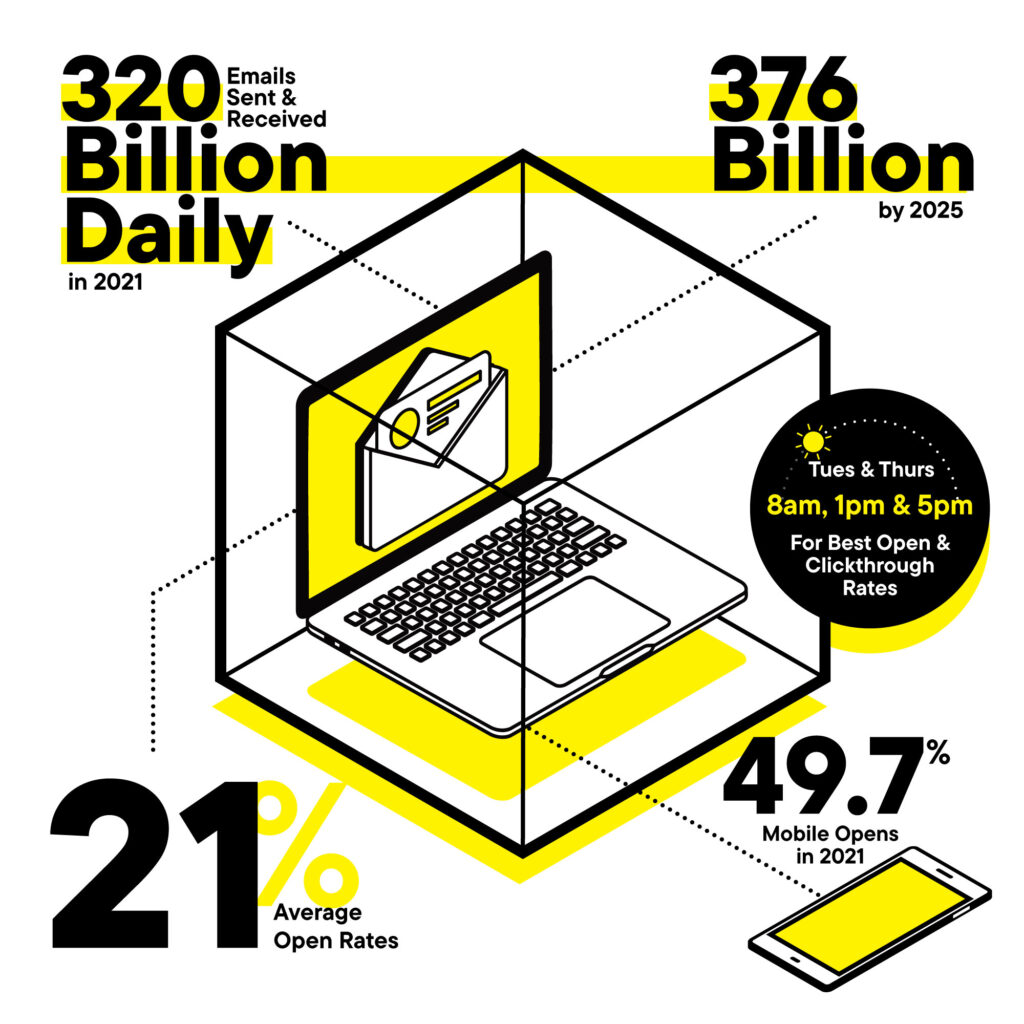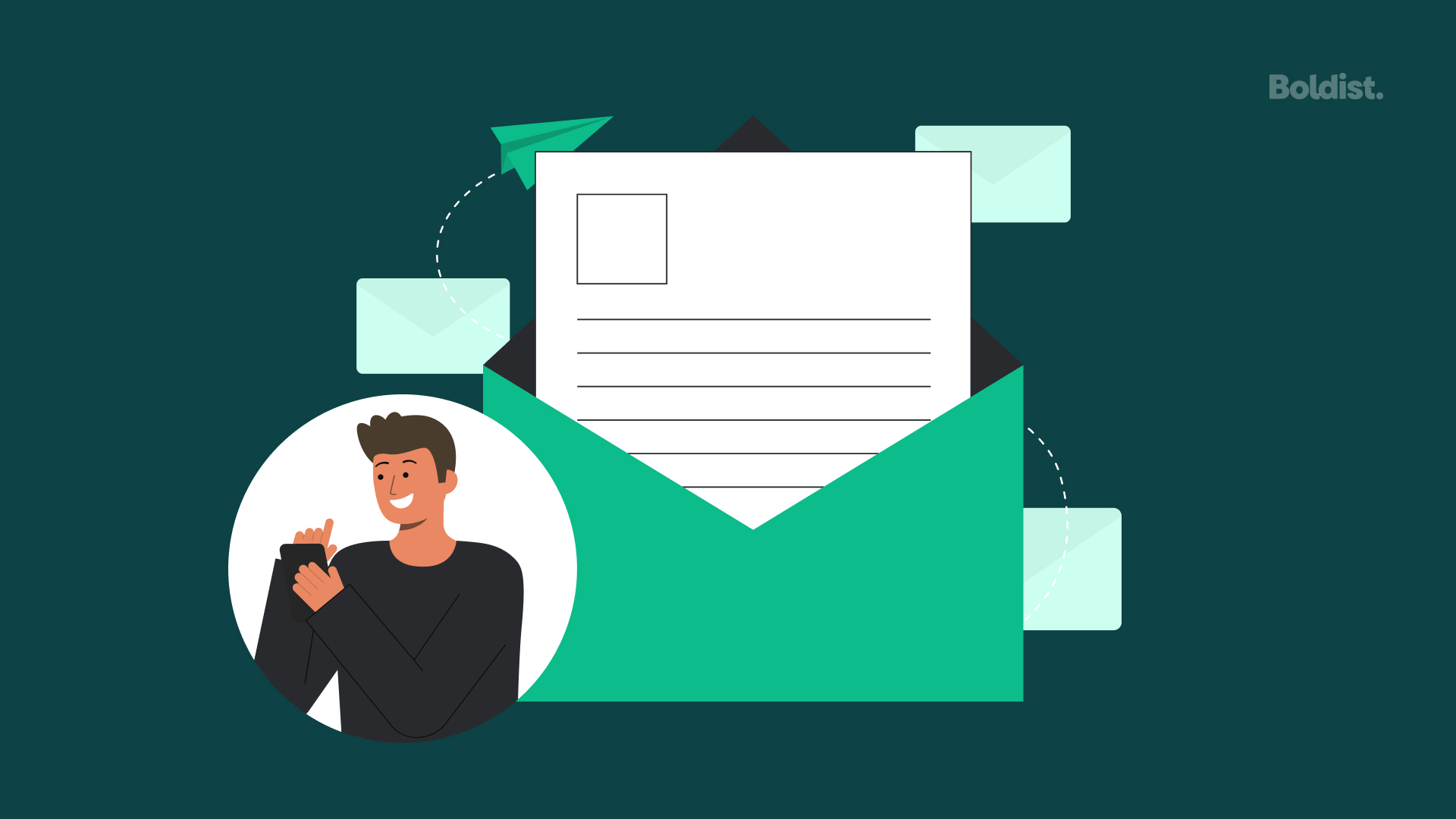Your newsletter is on life support.
Okay, that might seem a tad dramatic, but we can tell your current email marketing strategy isn’t working, or else you wouldn’t be here. In 2021, roughly 320 billion emails were sent and received each day. This figure is expected to increase to over 376 billion in 2025. And while it varies by industry and subject, the average email open rate is 21.33 percent. Based on that information you might ask yourself, “is email still relevant?”
The answer: YES.

Email marketing is one of the most cost-effective digital marketing tactics to reach and engage with your audience, in comparison to running social media ad campaigns or placing ads in publications. It allows you to easily personalize messaging with information you have collected from past emails, and segment them into different lists based on their interests.
But if your open rates are coming in below 20 percent, it might be time to revamp your email marketing strategy.
What Are Open Rates?
The email open rate is the measure or percentage of the total number of subscribers who opened your email. It is an important indicator of your email marketing campaign’s success, or failure, and helps marketers understand what needs to be improved upon.
Our inboxes are noisy, crowded, and competitive, so how can you increase your email open rates and stand out from the crowd?
Clean Up Your Email List
You should value quality over quantity in every aspect of your life, including your subscriber list. Over time, some of your subscribers will become inactive for any number of reasons and will stop opening your emails. It is important to clean up your email list regularly and update your email contact list to remove any inactive subscribers who are affecting your email open rate. This will result in a strong, engaged email list that will yield a better open and Clickthrough rate.
Before cleaning out your list, send out a re-engagement email drip campaign to bring them back, which allows you to create segmented email lists. Some effective methods for cleaning out your email list include removing hard bounces (undelivered) email addresses, removing duplicate and spammy addresses, and removing people who have unsubscribed.
Send Them at the Right Time
Unsure of when to send your email out to your subscribers? Research shows that Tuesday and Thursday and 8 a.m., 1 p.m. and 5 p.m. are the best days and times in terms of open and Clickthrough rates. You should avoid weekends unless you have timely information to share.
The key to finding out what the best date and time for your emails is considering your target audience’s tendencies, and the willingness to run tests to discover what works best for your audience.
Write a Catchy Subject Line
Your email subject line is your first impression. Some might even argue that it is the most important part of your email because your e-blast is worthless if no one feels enticed enough to open it. However, many marketers treat the subject line as an afterthought.
How can you guarantee that your message will be read?
Personalization
If you’re pulling data from a CRM, you can use that data to send highly personalized messages to your customers, which will result in higher read and Clickthrough rates. JetBlue does a great job at this, sending a monthly TrueBlue statement with the subscriber’s name on the subject line and personalized data inside, like the number of redeemable points.
Keep It Short and to the Point
Your subject line should be concise, but interesting. Also, keep in mind that a long subject line will be cut off in your inbox, so you want to grab their attention with as little characters as possible. Around 40 characters is ideal.
Use Numbers and Lists
Remember listicles? BuzzFeed perfected the art of the listicle and we marketers jumped at the chance to steal the format and make it ours. Incorporating numbers into your subject line attracts attention and creates curiosity.
Add Emojis
Emojis make your emails more visually appealing, help convey what words can’t, and they add personality to your brand. But as we’ve said before, we don’t recommend overusing emojis, and it’s not very inclusive to the blind and visually impaired. Make sure your emojis serve a purpose and don’t just insert them on your subject line because you can.
Flex Your Funny Bone
If appropriate to your demographic, it is okay to use humor. It is another great way to add personality to your brand and help your email stand-out in your audience’s inbox.
Use Actionable Language
Your subject line is essentially a call-to-action, and your language should reflect the actions you’d wish for your audience to take. Actionable subject lines will inspire your subscribers to click on your email by instilling urgency and excitement.
A/B Test
Whenever possible, create two varying subject lines and test them on a subject line tester tool, such as Mizy, which is free.
Marketers who take the time to create eye-catching subject lines run less of a risk of having their emails end up in the trash.
One timely example of poor subject headlines in my inbox was President Joe Biden’s newsletter. Most times, I couldn’t tell you what the emails were about because the subject lines were so boring, with random capitalization (or lack thereof), that I immediately deleted the email. Here are some examples from past months:
- every penny
- Hello
- I’m asking
- urgent and pressing
- counting on you
Was Joe himself writing the subject lines? One wonders…?
Create Mobile-Friendly Emails
According to research by Litmus in 2021, mobile opens accounted for 49.7 percent of all email opens. With that in mind, mobile-friendly design is crucial to improving your open rate.
To create a mobile-friendly email campaign, marketers must watch their subject line length and ensure the copy is concise because mobile phones have less screen space to work with than a desktop. When creating emails for a busy audience, get to the point quickly with the call-to-action front and center, and leave some breathing room so that your subscribers don’t accidentally click the wrong link.
Memorable Sender Name
One of the first things your recipient will do upon receiving your email is scan who the email is from, and using an effective sender name establishes a connection between your audience and the brand. Presenting your brand in a consistent manner allows your recipients to familiarize themselves with your email campaigns.
Some tips for memorable sender names, apart from just using your company name, include personalizing it, as our friends at the Orlando Weekly and Tasty Chomps do. Now, this works well if the sender is recognizable in the community, as “Jessica from Orlando Weekly” and “Ricky Ly from TastyChomps” are. Alternatively, you could use the name of your campaign, like how Sephora uses “Sephora Beauty Insider” as the sender name for the members of their rewards club.
Beware Spam Filters
Spam filters check for cues to automatically send an email to the junk folder, so it never reaches your subscriber’s inbox. Nearly 85% of emails are classified as spam, and while some of these are phishing scams and fraud, some of them are harmless and were just unlucky enough to trigger the spam alarm.
Common red flags to avoid include:
- Words that sound like a money scam, like “free” or “no cost”
- All-uppercase subject lines
- Excessive exclamation points
There are free tools available online to test your email, like UnSpam. Send your email to the test address, and it’ll let you know if it’ll sail straight to your audience’s junk folder, never to be seen again.
Ditch the No-Reply Email
Nothing seems colder than a no-reply email address. Now, we’re not asking for you to send the email from your personal email address—especially if you have thousands of subscribers! But no-reply emails harm two-way communication, and it increases the chances of your email ending up in the spam folder.
We recommend creating an email address, such as hello@yourbrandname.com instead, and if a customer emails your brand using that email address, you can set up an automatic email to reply with a list of resources, phone numbers, or a customer service email for them to contact.
Design With Accessibility in Mind
As marketers, we should always strive to widen our customer base, and one way to accomplish that is by designing email templates for accessibility. There are billions of people worldwide who suffer from vision impairment or blindness, so design in a way that this audience can access, perceive, and interact with your marketing campaigns. Consider using large, accessible fonts and appropriate colors, avoiding blocks of text, using alt-text for images, and paying attention to formatting and navigation.
These actionable email marketing best practices can help your business get better open rates, but it might not happen right away. Email marketing is an art, so give yourself some wiggle room to test things out and learn what best works for your subscribers.

